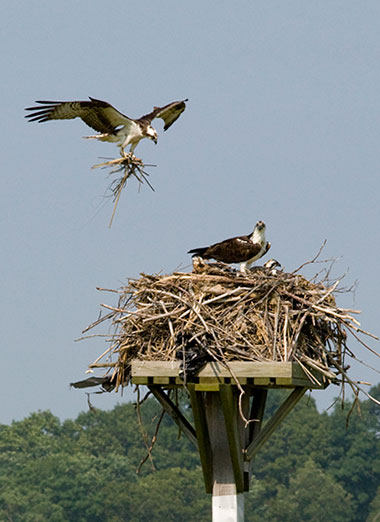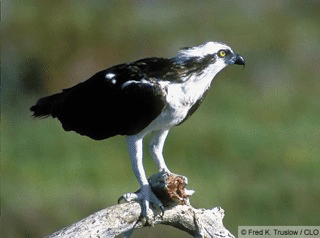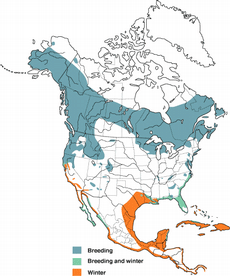Thachbed Island Osprey Return
The Land Trust's Thatchbed Island property is once again hosting our returning Ospreys. Having wintered in the warmer climates of Central and South America, the arrival of Ospreys towards the end of March is the clearest indication that Spring is on its way. The Essex Land Trust's OspreyCam has not been operational for the past two seasons due to battery and camera problems. These are now resolved and we took advantage of these repairs to upgrade the camera to digital quality.
Ospreys continue to make a remarkable comeback after having practically disappeared from our coastal region in the 1970s and 1980s. In 2017, the Connecticut Audubon Society's Osprey Nation Citizen Science Program monitored 540 nest sites throughout the state. Of these sites, there were 394 active nests and 607 total fledglings observed in the state. Ospreys are now occupying new nesting sites that are further inland than their historical range along the Connecticut coast.
Click the display below to launch video footage from prior years broadcast. The Middlesex County Community Foundation/Riverview Cemetery generously funded the initial installation of the Essex Land Trust OspreyCam.
The live streaming of the Essex Land Trust OspreyCam will begin in April and is made possible by the generous support of Essex Savings Bank.

OspreyCam Video Recordings
OspreyCam video clips from prior years can be seen by visiting the ELT YouTube page Here.


All About Ospreys
The following information has been gleaned from Birds of North America Online, sponsored by Cornell Lab of Ornithology and the American Ornithologists Union.


Arguably North America’s best-studied bird of prey, and certainly one of its most admired, the Osprey is the continent’s only raptor that eats almost exclusively live fish. Despite this restriction, Ospreys have colonized a broad array of habitats. Ospreys dive feet first for their prey, accessing only about the top meter of water, so they are restricted to surface-schooling fish and to those in shallows—the latter generally most abundant and available. These birds live throughout the world along rivers, lakes, seacoasts, and bays. Ospreys in northern regions migrate to warm areas for the winter. Ospreys are most common around major coastal estuaries and salt marshes, but are regular around large lakes, reservoirs, and rivers.
Osprey have an exceptionally high fidelity to their breeding site and winter home range: studies show that generally more than 80% of 150 breeding pairs monitored in southeastern New England returned to breeding sites year to year. What makes this level of fidelity more remarkable is that breeding pairs do not migrate or winter together.
In southern New England, first arrivals are from mid-to-late March with eggs laid from early April until early June. Generally the male seeks a nest site, before arrival of the female, but pairs do visit sites together. The male may start nest building before pairing; females are not known to do so. Rarely single females will settle at a nest site before pairing, especially if they have bred at the site previously. Throughout the U.S., pairs have produced significantly more young (about twice as many) at artificial sites as at natural sites. This is in part because trees generally are less stable than artificial sites as they are more likely to blow down during breeding season and between. Thus Osprey populations with access to artificial nesting sites (such as platforms) tend to grow more quickly than those confined to natural sites.


Egg laying generally takes place soon after the nest takes shape and nest lining is added; nest material continues to be added throughout laying and incubation, but at a reduced rate. The male vigorously guards its mate during this time; follows her whenever she leaves the nest, roosts nearby, away only when foraging.
Typically, the male brings fish to the nest, or nearby, often feeding first before presenting the remainder to the female. The female distributes food to nestlings, seemingly feeding whichever begs closest and most vigorously. The female dissects small pieces of fish and carefully presents them in her bill, generally from the anterior portion of the fish, working toward the tail; the female discards or eats bones and hard parts herself and often eats the entire tail in one gulp. By about 40 days of age, the young begin to feed on their own, taking prey from the male as he lands at the nest or from the female parent after she has fed. With large young, however, the female generally feeds last.
In southern New England, first flight is generally at 50–55 days of age. During the last days of the nestling period, young often exercise their wings at the edge of the nest. Young are susceptible to premature fledging; i.e., if disturbed at the nest, they may jump before they can fly well, forcing a landing on ground or in water and jeopardizing survival.
After first flight, young generally remain at the nest or nearby; parents bring fish back to perched young, who rip it apart to feed themselves. Parental feeding seems to provide a key transition to independence, perhaps one reason fewer young that fledge late (and thus get less parental feeding) survive. Fall Migration typically begins in August, although individuals (generally failed breeders) may leave earlier and wander widely before beginning true migration. September is reported as the peak period for migration.



